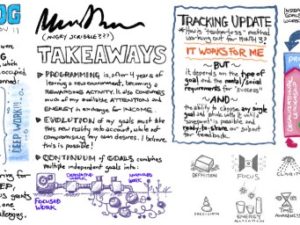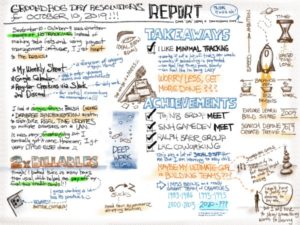(last edited on February 15, 2023 at 12:24 pm)
A perennial challenge for me is starting new project tasks quickly. My attention is quite easily scattered when I’m working in isolation, and it’s made worse if I’m not sure exactly what I have to do and what I will get in return for my effort. The trick I use to get moving is “stream of consciousness”-style writing, which works because it creates a write-read-refine feedback loop that stitches my thoughts into a clean line of reasoning. And because it’s written down, I can refer back to it when my attention wanders again.
The real trick is remembering that writing gets me unstuck. Rather than turn to it as a last resort, I should really make it a first habit. I don’t think that even occurred to me because I write SO MUCH already; by my last count, there are about two dozen places where I write on a weekly basis. I’d like to create a focused writing habit to serve as the trigger for a productive work sprint, and I think that means I need to develop some disciplined process in my writing.
Over the past 10 years, I’ve implemented the “one location” as a continuity journal, using many different tools and approaches. None of them have lasted more than six months because inevitably they become overgrown with too much information, which becomes distracting.
So, let’s try to fix that.
Supporting Writing and Thinking
As I mentioned earlier, I write to get unstuck by straightening out my thoughts. When I’m writing a sentence, I naturally must consider the order of my words for maximum clarity. This automatically creates logical structure and hierarchy in the ideas that I’m discussing, which I can then use to make design and implementation decisions.
I can break this down as three motivating issues:
I’m having trouble starting the day because recalling where I left off is difficult. Writing helps me visualize what to do by telling a story. The linear flow of describing dependent actions, necessitated by the structure of sentences following sentences in paragraphs, helps me see first actions and fill in gaps in the narrative I am creating.
I’m trying to understand something new and unfamiliar.** The narrative also helps by enriching my understanding of the problem. When I write, I am building a scaffold relating agents, intentions, actions, and outcomes into a mental model that I can follow, and therefore reason with. Big picture.
I’m worried about forgetting the process details itself. I have a terrible short term memory for arbitrary details. A strong narrative and mental model to follow helps anchor details in contextual memory, which for me is more reliable. However, I still need to commit the narrative and model itself as documentation. Detail view.
Prototype System
To recap, the general idea is to have a tool+process that helps me rapidly start work tasks by dealing with these issues. Starting is the hardest thing for me, but once I’m going on a problem I’m usually good for at least a couple hours.
Making the startup process should be as simple and efficient as possible. This including reducing the amount of clutter and keeping the writing environment as pure as possible. Here’s my starting list for the new system:
- Has a single location for all writing.
- Can be launched with one-click startup.
- Provides cross-platform access from all devices.
- Is a pleasant writing environment without distracting production features.
- Has flexible writing tools for thinking on-the-fly.
- Has adequate formatting to make reading pleasurable for later recall.
- Has a convention for designating references outside of the system.
I have many of these pieces already from past experiment, so here’s what I’m doing:
- For the location: I’m using my knowledge management folder
KM, which already has a@Continuityfolder where I kept past iterations. This keeps the continuity files in the same master directory as all my other notes. - I’m also going to move the entire
KMfolder to my Dropbox folder so it’s automatically synchronized between all of my computers and devices. This folder used to be synched with an upstream GitHub repository, but I think Dropbox will make it easier. - For one-click startup, I’ll use the Typora Markdown editor. It’s available on all major platforms. I’ve updated my Alfred MacOS Automation script that will let me type
GO MEand it will magically open Typora with theKM/@Continuityfolder. Not quite one click, but super fast!
 That takes are of the technical nuts and bolts. What’s left now is to try reading/writing in this every day to see if it works at all.
That takes are of the technical nuts and bolts. What’s left now is to try reading/writing in this every day to see if it works at all.
Results
I’ll update this blog post as the experiment continues!





1 Comment
Sounds complicated. Have you tried Drafts? Or NotePlan, which integrates markdown notes with your calendar? Both macOS/iOS xplat, and with NotePlan you can edit the underlying text files in any text editor on other platforms as well if you need to.